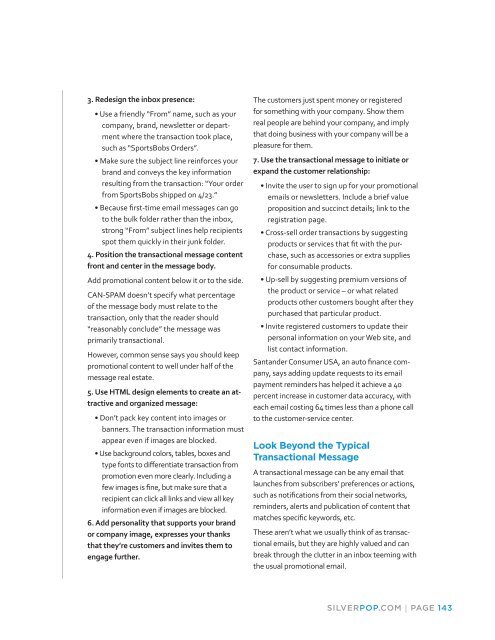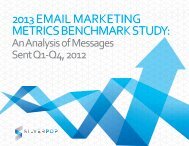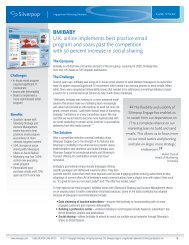eBook - Silverpop
eBook - Silverpop
eBook - Silverpop
Create successful ePaper yourself
Turn your PDF publications into a flip-book with our unique Google optimized e-Paper software.
3. Redesign the inbox presence:<br />
• Use a friendly “From” name, such as your<br />
company, brand, newsletter or department<br />
where the transaction took place,<br />
such as “SportsBobs Orders”.<br />
• Make sure the subject line reinforces your<br />
brand and conveys the key information<br />
resulting from the transaction: “Your order<br />
from SportsBobs shipped on 4/23.”<br />
• Because first-time email messages can go<br />
to the bulk folder rather than the inbox,<br />
strong “From” subject lines help recipients<br />
spot them quickly in their junk folder.<br />
4. Position the transactional message content<br />
front and center in the message body.<br />
Add promotional content below it or to the side.<br />
CAN-SPAM doesn’t specify what percentage<br />
of the message body must relate to the<br />
transaction, only that the reader should<br />
“reasonably conclude” the message was<br />
primarily transactional.<br />
However, common sense says you should keep<br />
promotional content to well under half of the<br />
message real estate.<br />
5. Use HTML design elements to create an attractive<br />
and organized message:<br />
• Don’t pack key content into images or<br />
banners. The transaction information must<br />
appear even if images are blocked.<br />
• Use background colors, tables, boxes and<br />
type fonts to differentiate transaction from<br />
promotion even more clearly. Including a<br />
few images is fine, but make sure that a<br />
recipient can click all links and view all key<br />
information even if images are blocked.<br />
6. Add personality that supports your brand<br />
or company image, expresses your thanks<br />
that they’re customers and invites them to<br />
engage further.<br />
The customers just spent money or registered<br />
for something with your company. Show them<br />
real people are behind your company, and imply<br />
that doing business with your company will be a<br />
pleasure for them.<br />
7. Use the transactional message to initiate or<br />
expand the customer relationship:<br />
• Invite the user to sign up for your promotional<br />
emails or newsletters. Include a brief value<br />
proposition and succinct details; link to the<br />
registration page.<br />
• Cross-sell order transactions by suggesting<br />
products or services that fit with the purchase,<br />
such as accessories or extra supplies<br />
for consumable products.<br />
• Up-sell by suggesting premium versions of<br />
the product or service – or what related<br />
products other customers bought after they<br />
purchased that particular product.<br />
• Invite registered customers to update their<br />
personal information on your Web site, and<br />
list contact information.<br />
Santander Consumer USA, an auto finance company,<br />
says adding update requests to its email<br />
payment reminders has helped it achieve a 40<br />
percent increase in customer data accuracy, with<br />
each email costing 64 times less than a phone call<br />
to the customer-service center.<br />
Look Beyond the Typical<br />
Transactional Message<br />
A transactional message can be any email that<br />
launches from subscribers’ preferences or actions,<br />
such as notifications from their social networks,<br />
reminders, alerts and publication of content that<br />
matches specific keywords, etc.<br />
These aren’t what we usually think of as transactional<br />
emails, but they are highly valued and can<br />
break through the clutter in an inbox teeming with<br />
the usual promotional email.<br />
SILVERPOP.COM | PAGE 143







